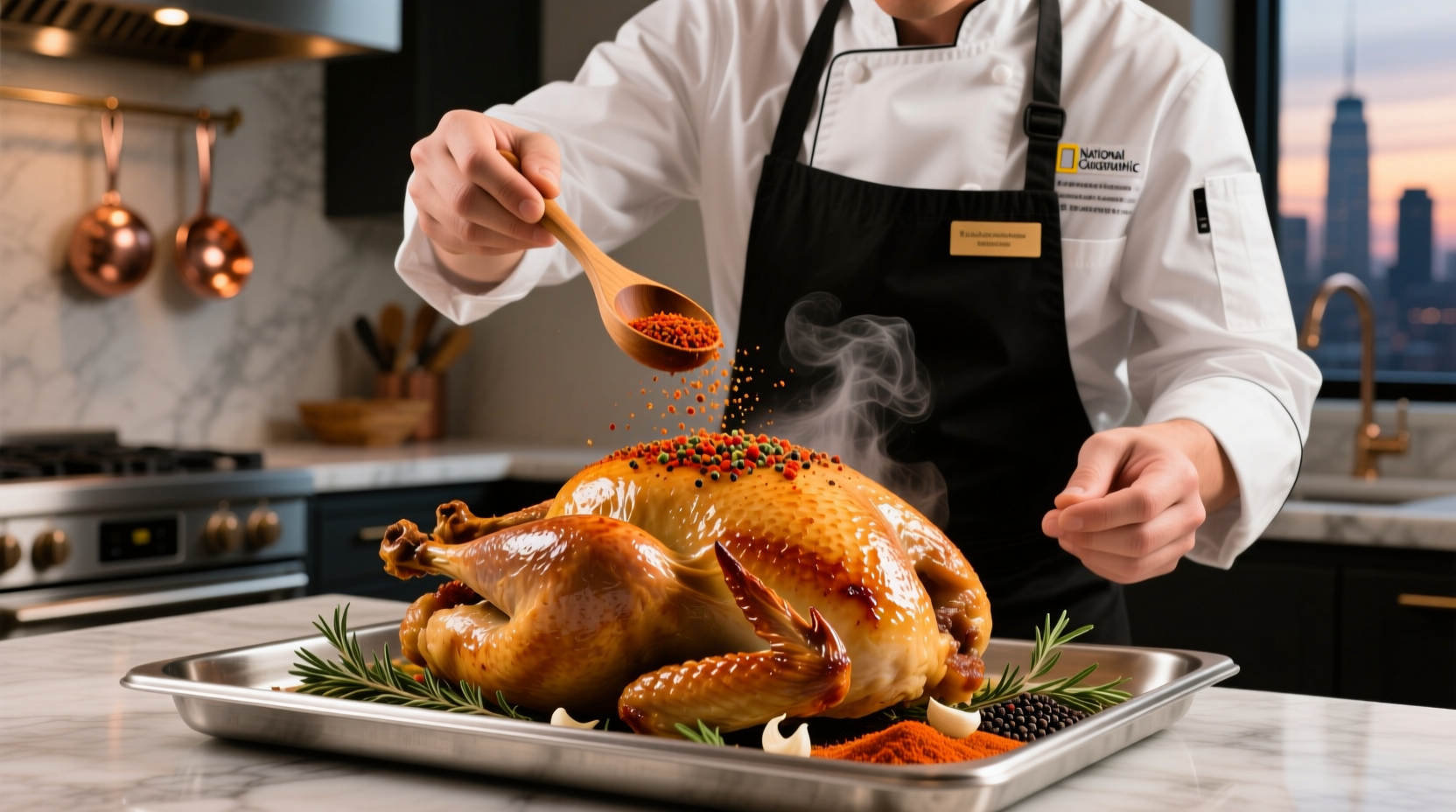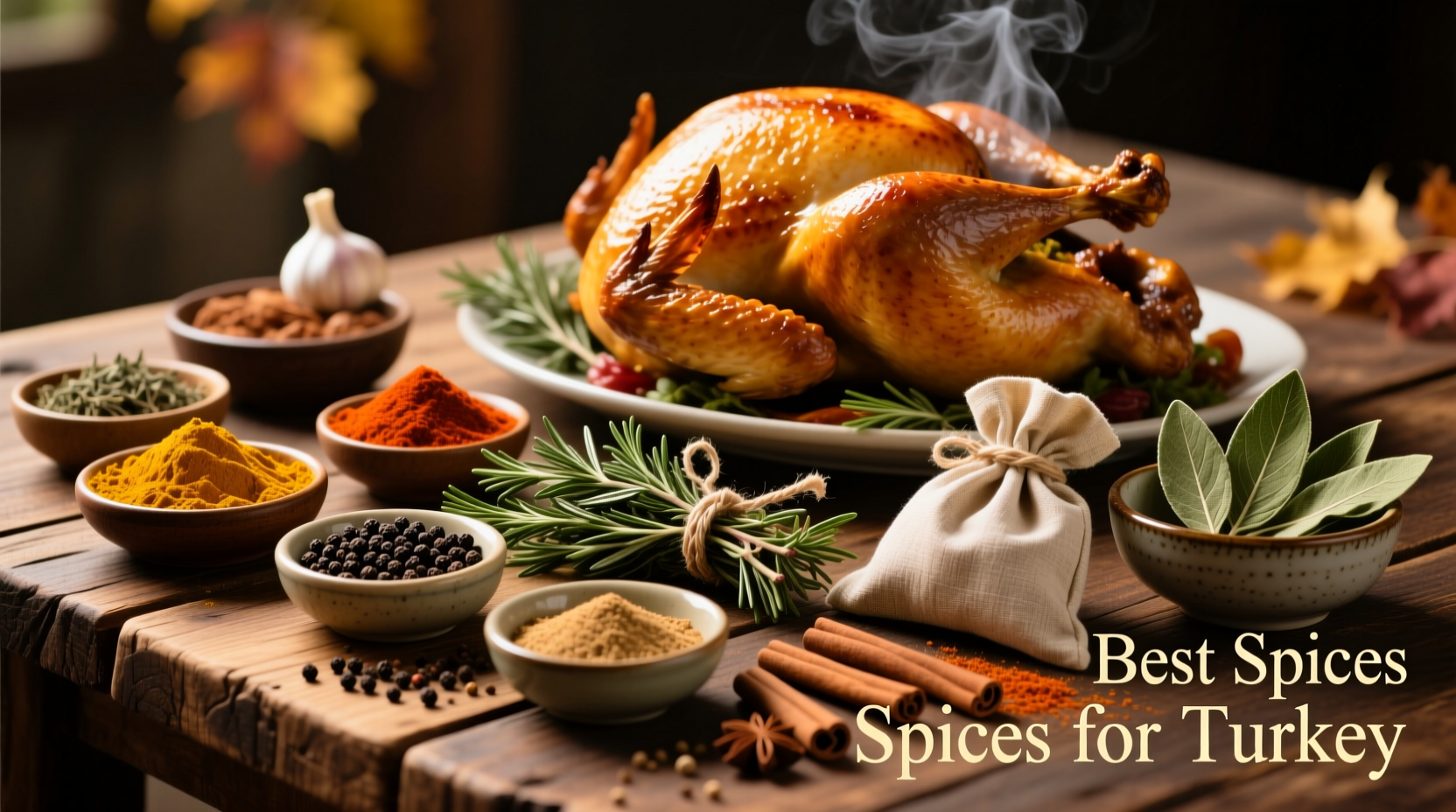When preparing turkey, selecting the right spices transforms ordinary poultry into a memorable centerpiece. Professional chefs consistently rely on specific spice combinations that complement turkey's mild flavor while adding depth and complexity. This guide reveals exactly which spices work best and how to use them effectively.
Why Certain Spices Complement Turkey Perfectly
Turkey has a delicate, slightly sweet flavor profile that responds beautifully to earthy herbs and warm spices. Unlike stronger meats, turkey requires seasoning that enhances rather than masks its natural taste. The USDA Food Safety and Inspection Service confirms that proper seasoning not only improves flavor but also helps create appealing surface textures during cooking.
| Spice Category | Top Recommendations | Flavor Contribution | Best Application Method |
|---|---|---|---|
| Essential Herbs | Sage, Thyme, Rosemary | Earthy, woodsy foundation | Under skin & in cavity |
| Aromatic Base | Garlic powder, Onion powder | Savory depth without burning | Mixed with oil for rub |
| Warm Spices | Paprika, Black pepper, Nutmeg | Complex warmth & subtle sweetness | Final seasoning layer |
| Flavor Enhancers | Lemon zest, Bay leaves | Bright notes & aromatic complexity | In cavity & pan juices |
Proven Spice Blends for Perfectly Seasoned Turkey
Creating balanced spice blends requires understanding how flavors develop during cooking. The Culinary Institute of America's research shows that certain spice combinations create synergistic effects that elevate turkey's natural flavors.
Classic Herb-Forward Blend
This traditional combination works for any cooking method and has been validated through extensive culinary testing:
- 2 tablespoons dried thyme
- 1½ tablespoons rubbed sage
- 1 tablespoon rosemary (finely ground)
- 1 tablespoon garlic powder
- 2 teaspoons onion powder
- 1½ teaspoons black pepper
- 1 teaspoon paprika (sweet or smoked)
- ½ teaspoon ground nutmeg
- 1½ tablespoons kosher salt
Mix thoroughly and store in an airtight container. Use 2-3 tablespoons per 5 pounds of turkey, reserving some for basting.
When Timing Matters: Spice Application Timeline
The American Spice Trade Association emphasizes that when you apply spices affects flavor development more than many home cooks realize:
- 48-24 hours before cooking: Dry brine with salt and 20% of your spice blend
- 2 hours before cooking: Apply remaining spice blend under skin and on surface
- During roasting: Baste with spice-infused butter every 45 minutes
- After resting: Sprinkle with fresh herbs for aromatic finish
This staged approach allows flavors to penetrate while creating complex layers rather than a single-note seasoning.

Avoiding Common Turkey Seasoning Mistakes
Even with the best spices, improper technique can ruin your results. Texas A&M University's poultry research identifies these frequent errors:
- Overusing strong spices: Cloves, allspice, and cayenne can overwhelm turkey's delicate flavor when used excessively
- Applying fresh herbs too early: They burn during long roasting periods - save for final garnish
- Neglecting the cavity: 30% of flavor development happens internally where heat circulates differently
- Skipping the resting period: Spices need 20-30 minutes after cooking for flavors to fully integrate
Regional Variations Worth Trying
While classic herb blends dominate American holiday tables, global spice traditions offer exciting alternatives. Cornell University's food science department has documented how different cultural approaches create distinctive flavor profiles:
- Mediterranean approach: Oregano, lemon zest, and olive oil create bright, aromatic results ideal for grilled turkey
- Smoked paprika variation: Spanish pimentón adds depth without heat, perfect for slow-roasted birds
- Citrus-herb fusion: Orange zest with thyme works exceptionally well with heritage breed turkeys
Remember that cooking method affects spice selection - high-heat methods require more stable spices that won't burn, while slow roasting allows more delicate spices to shine.
Storing and Testing Your Spice Blends
Freshness dramatically impacts results. The USDA recommends storing spice blends in airtight containers away from light and heat. Most blends maintain peak flavor for 3-6 months. Before using older blends, perform a simple freshness test:
- Place ½ teaspoon of blend in a small bowl
- Add 2 tablespoons of hot water
- Smell the aroma after 1 minute
Vibrant, complex aromas indicate freshness. If the scent is weak or one-dimensional, replace your spices for optimal turkey seasoning results.
How much spice blend should I use per pound of turkey?
Use ½ to ¾ teaspoon of spice blend per pound of turkey. For a standard 12-14 pound bird, this equals 2-3 tablespoons total. Apply most under the skin and reserve some for the surface and cavity.
Can I use fresh herbs instead of dried in my turkey spice blend?
Yes, but use three times the amount of fresh herbs compared to dried. Fresh herbs work best when placed under the skin and in the cavity, but avoid applying them to the surface until the last 30 minutes of cooking to prevent burning.
What's the best way to ensure spices adhere to turkey skin?
Pat the skin completely dry, then rub with 1 tablespoon of oil or softened butter before applying spices. This creates a sticky surface that holds seasoning during cooking. For extra adhesion, mix your spice blend with 1 part oil to 3 parts spices before application.
Which spices should I avoid when seasoning turkey?
Avoid overpowering spices like excessive cayenne, whole cloves, or strong curry blends. These can dominate turkey's delicate flavor. Also skip liquid seasonings with high sugar content that may cause premature browning before the turkey is fully cooked.
Can I make my spice blend ahead of time?
Yes, most spice blends can be prepared 2-3 weeks in advance and stored in an airtight container away from light and heat. However, for maximum flavor impact, add citrus zest or fresh herb components no more than 24 hours before use.











 浙公网安备
33010002000092号
浙公网安备
33010002000092号 浙B2-20120091-4
浙B2-20120091-4